weight Peugeot 301 2015 Owner's Manual
[x] Cancel search | Manufacturer: PEUGEOT, Model Year: 2015, Model line: 301, Model: Peugeot 301 2015Pages: 285, PDF Size: 13.55 MB
Page 5 of 285
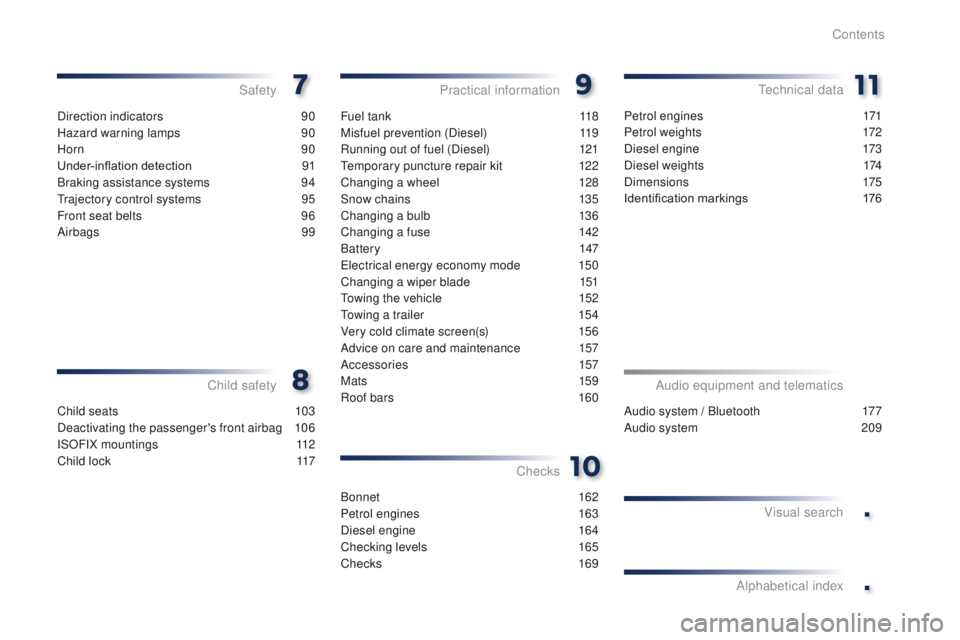
.
.
Direction indicators 90
Hazard warning lamps
9
0
Horn
90
Under-inflation detection
9
1
Braking assistance systems
9
4
Trajectory control systems
9
5
Front seat belts
9
6
Airbags
9
9
Safety
Child seats 103
Deactivating the passenger's front airbag
1
06
ISOFIX mountings
1
12
Child lock
1
17
Child safety
Fuel tank 118
Misfuel prevention (Diesel)
1
19
Running out of fuel (Diesel)
1
21
Temporary puncture repair kit
1
22
Changing a wheel
1
28
Snow chains
1
35
Changing a bulb
1
36
Changing a fuse
1
42
Battery
1
47
Electrical energy economy mode
1
50
Changing a wiper blade
1
51
Towing the vehicle
1
52
Towing a trailer
1
54
Very cold climate screen(s)
1
56
Advice on care and maintenance
1
57
Accessories
157
Mats
159
Roof bars
1
60
Practical information
Petrol engines 1 71
Petrol weights
1
72
Diesel engine
1
73
Diesel weights
1
74
Dimensions
175
Identification markings
1
76
Technical data
Audio system / Bluetooth 177
Audio system
2
09
Audio equipment and telematics
Visual search
Alphabetical index
Checks
Bonnet
162
Petrol engines
1
63
Diesel engine
1
64
Checking levels
1
65
Checks
16
9
Contents
Page 23 of 285
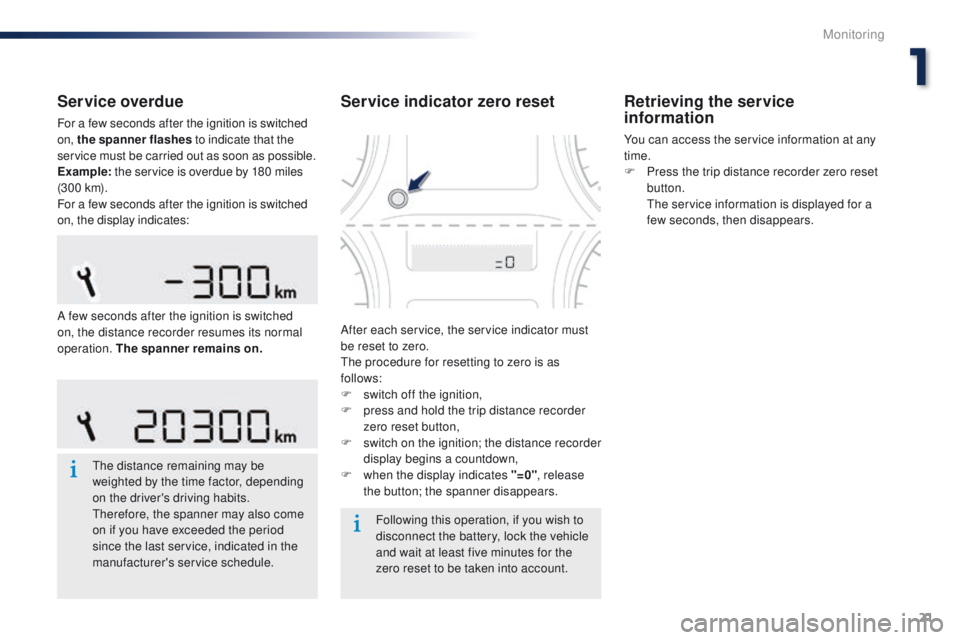
21
301_en_Chap01_controle-de-marche_ed01-2014
Service overdue
For a few seconds after the ignition is switched
on, the spanner flashes to indicate that the
service must be carried out as soon as possible.
Example: the service is overdue by 180 miles
(3 0 0 k m).
For a few seconds after the ignition is switched
on, the display indicates:
The distance remaining may be
weighted by the time factor, depending
on the driver's driving habits.
Therefore, the spanner may also come
on if you have exceeded the period
since the last service, indicated in the
manufacturer's service schedule. Following this operation, if you wish to
disconnect the battery, lock the vehicle
and wait at least five minutes for the
zero reset to be taken into account.
Service indicator zero reset
After each service, the service indicator must
be reset to zero.
The procedure for resetting to zero is as
follows:
F
s
witch off the ignition,
F
p
ress and hold the trip distance recorder
zero reset button,
F
s
witch on the ignition; the distance recorder
display begins a countdown,
F
w
hen the display indicates "=0" , release
the button; the spanner disappears.
Retrieving the service
information
You can access the service information at any
time.
F
P
ress the trip distance recorder zero reset
button.
T
he service information is displayed for a
few seconds, then disappears.
A few seconds after the ignition is switched
on, the distance recorder resumes its normal
operation. The spanner remains on .
1
Monitoring
Page 105 of 285
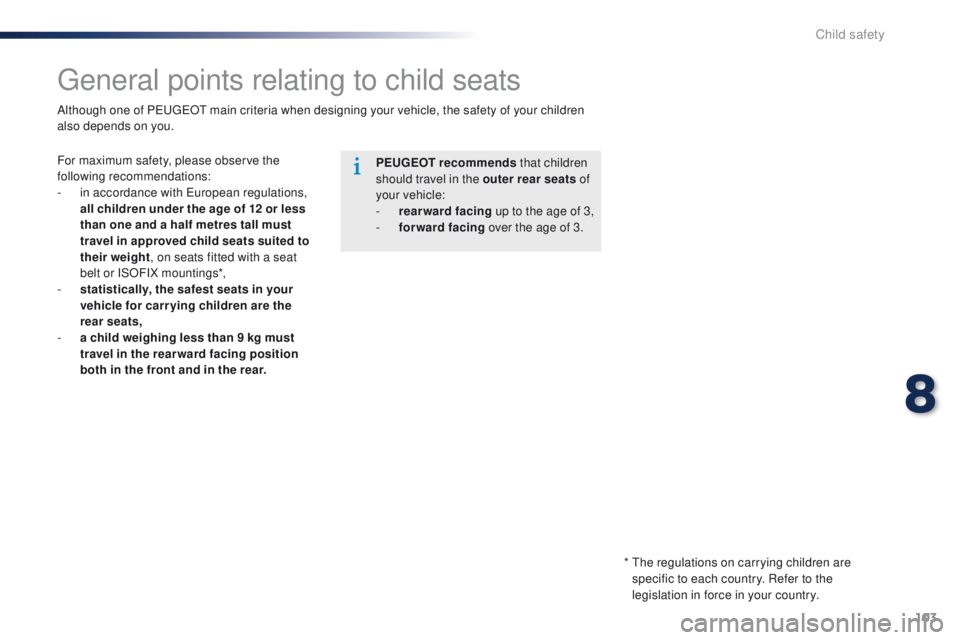
103
301_en_Chap08_securite-enfants_ed01-2014
General points relating to child seats
For maximum safety, please observe the
following recommendations:
-
i
n accordance with European regulations,
all children under the age of 12 or less
than one and a half metres tall must
travel in approved child seats suited to
their weight , on seats fitted with a seat
belt or ISOFIX mountings*,
-
s
tatistically, the safest seats in your
vehicle for carr ying children are the
rear seats,
-
a c
hild weighing less than 9 kg must
travel in the rear ward facing position
both in the front and in the rear. PEUGEOT recommends
that children
should travel in the outer rear seats of
your vehicle:
-
re
arward facing up to the age of 3,
-
fo
rward facing over the age of 3.
Although one of PEUGEOT main criteria when designing your vehicle, the safety of your children
also depends on you.
*
T
he regulations on carrying children are
specific to each country. Refer to the
legislation in force in your country.
8
Child safety
Page 112 of 285
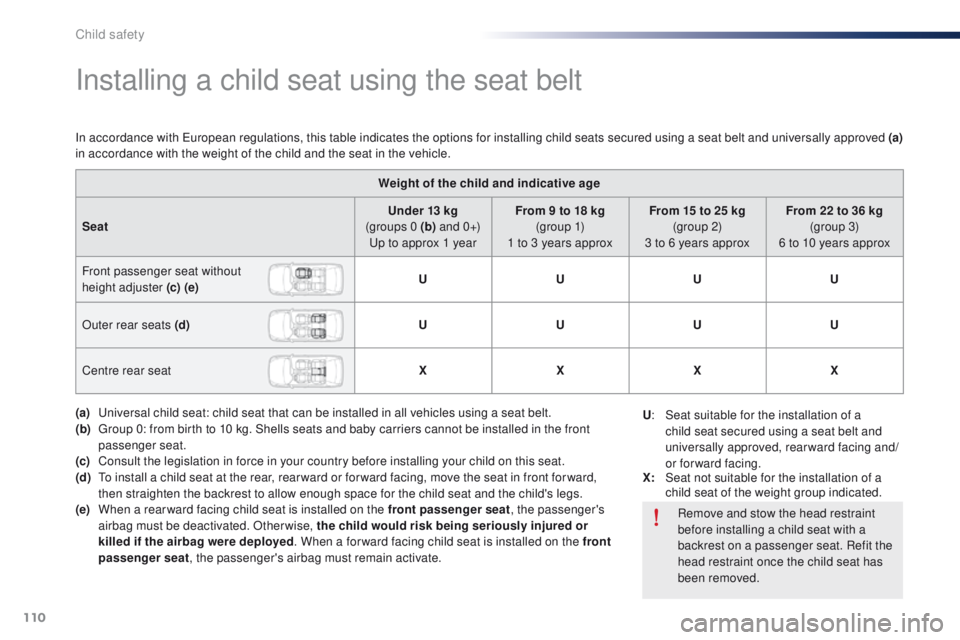
110
301_en_Chap08_securite-enfants_ed01-2014
Installing a child seat using the seat belt
Weight of the child and indicative age
Seat Under 13 kg
(groups 0 (b) a n d 0 +)
Up to approx 1 year From 9 to 18 kg
(g r o u p 1)
1 to 3 years approx From 15 to 25 kg
(group 2)
3 to 6 years approx From 22 to 36 kg
(group 3)
6 to 10 years approx
Front passenger seat without
height adjuster (c) (e) U
UUU
Outer rear seats (d) UUUU
Centre rear seat XXXX
(a)
U
niversal child seat: child seat that can be installed in all vehicles using a seat belt.
(b )
G
roup 0: from birth to 10 kg. Shells seats and baby carriers cannot be installed in the front
passenger seat.
(c )
C
onsult the legislation in force in your country before installing your child on this seat.
(d)
T
o install a child seat at the rear, rear ward or for ward facing, move the seat in front for ward,
then straighten the backrest to allow enough space for the child seat and the child's legs.
(e)
W
hen a rear ward facing child seat is installed on the front passenger seat , the passenger's
airbag must be deactivated. Otherwise, the child would risk being seriously injured or
killed if the airbag were deployed . When a for ward facing child seat is installed on the front
passenger seat , the passenger's airbag must remain activate.
In accordance with European regulations, this table indicates the options for installing child seats secured using a seat belt and universally approved
(a)
in accordance with the weight of the child and the seat in the vehicle.
Remove and stow the head restraint
before installing a child seat with a
backrest on a passenger seat. Refit the
head restraint once the child seat has
been removed.
U
:
S
eat suitable for the installation of a
child seat secured using a seat belt and
universally approved, rearward facing and/
or forward facing.
X:
S
eat not suitable for the installation of a
child seat of the weight group indicated.
Child safety
Page 118 of 285
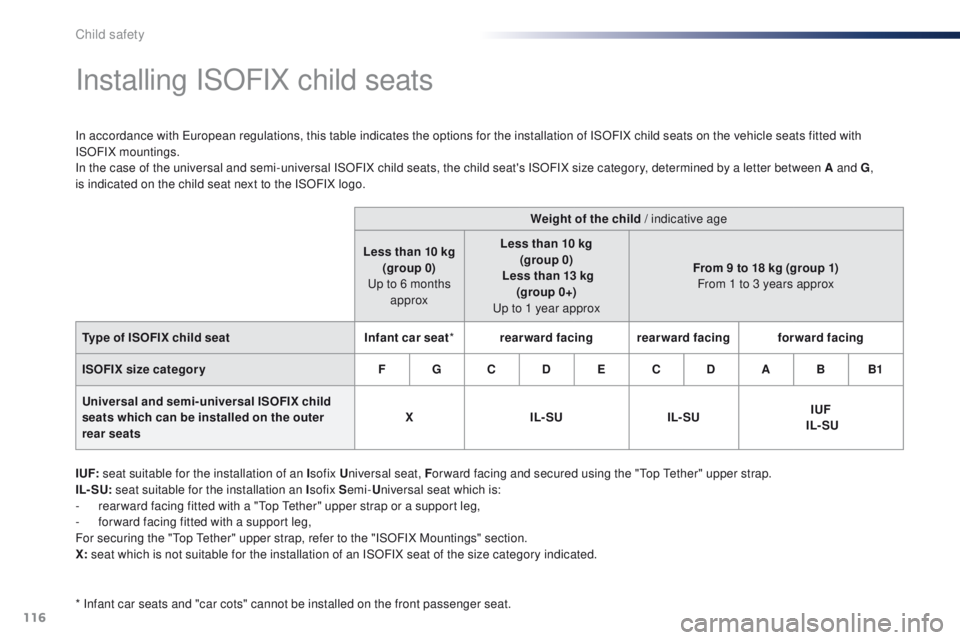
116
301_en_Chap08_securite-enfants_ed01-2014
Installing ISOFIX child seats
In accordance with European regulations, this table indicates the options for the installation of ISOFIX child seats on the vehicle seats fitted with
ISOFIX mountings.
In the case of the universal and semi-universal ISOFIX child seats, the child seat's ISOFIX size category, determined by a letter between A and G,
is indicated on the child seat next to the ISOFIX logo.
Weight of the child / indicative age
Less than 10 kg (group 0)
Up to 6 months approx Less than 10 kg
(group 0)
Less than 13 kg (group 0+)
Up to 1 year approx From 9 to 18 kg (group 1)
From 1 to 3 years approx
Type of ISOFIX child seat Infant car seat*rearward facing rearward facing forward facing
ISOFIX size categor y F G C D E C D A B B1
Universal and semi-universal ISOFIX child
seats which can be installed on the outer
rear seats X
IL- SU IL- SU IUF
IL- SU
I UF: seat suitable for the installation of an I sofix Universal seat, F or ward facing and secured using the "Top Tether" upper strap.
IL- SU: seat suitable for the installation an I sofix Semi-Universal seat which is:
-
r
ear ward facing fitted with a "Top Tether" upper strap or a support leg,
-
f
or ward facing fitted with a support leg,
For securing the "Top Tether" upper strap, refer to the "ISOFIX Mountings" section.
X: seat which is not suitable for the installation of an ISOFIX seat of the size category indicated.
* Infant car seats and "car cots" cannot be installed on the front passenger seat.
Child safety
Page 154 of 285
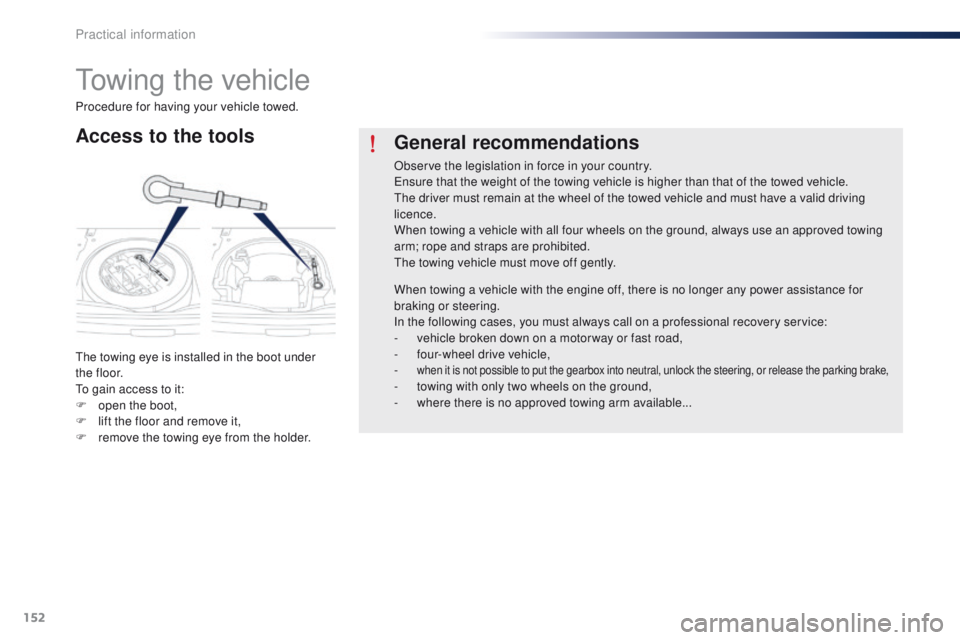
152
301_en_Chap09_info-pratiques_ed01-2014
Towing the vehicle
Access to the tools
The towing eye is installed in the boot under
t h e f l o o r.
To gain access to it:
F
o
pen the boot,
F
l
ift the floor and remove it,
F
r
emove the towing eye from the holder.
General recommendations
Observe the legislation in force in your country.
Ensure that the weight of the towing vehicle is higher than that of the towed vehicle.
The driver must remain at the wheel of the towed vehicle and must have a valid driving
licence.
When towing a vehicle with all four wheels on the ground, always use an approved towing
arm; rope and straps are prohibited.
The towing vehicle must move off gently.
When towing a vehicle with the engine off, there is no longer any power assistance for
braking or steering.
In the following cases, you must always call on a professional recovery service:
-
v
ehicle broken down on a motor way or fast road,
-
f
our-wheel drive vehicle,
-
when it is not possible to put the gearbox into neutral, unlock the steering, or release the parking brake,- towing with only two wheels on the ground,
- w here there is no approved towing arm available...
Procedure for having your vehicle towed.
Practical information
Page 157 of 285
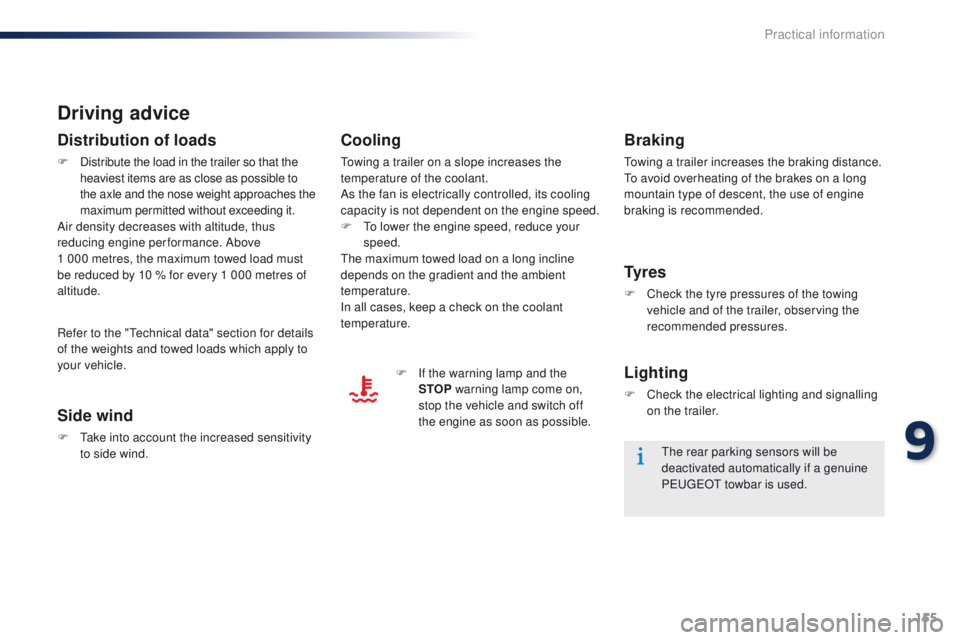
155
301_en_Chap09_info-pratiques_ed01-2014
Driving advice
Distribution of loads
F Distribute the load in the trailer so that the heaviest items are as close as possible to
the axle and the nose weight approaches the
maximum permitted without exceeding it.
Air density decreases with altitude, thus
reducing engine performance. Above
1
000 metres, the maximum towed load must
be reduced by 10
% for every 1 000 metres of
altitude.
Side wind
F Take into account the increased sensitivity to side wind.
Cooling
Towing a trailer on a slope increases the
temperature of the coolant.
As the fan is electrically controlled, its cooling
capacity is not dependent on the engine speed.
F
T
o lower the engine speed, reduce your
speed.
The maximum towed load on a long incline
depends on the gradient and the ambient
temperature.
In all cases, keep a check on the coolant
temperature.
F
I
f the warning lamp and the
STOP warning lamp come on,
stop the vehicle and switch off
the engine as soon as possible.
Braking
Towing a trailer increases the braking distance.
To avoid overheating of the brakes on a long
mountain type of descent, the use of engine
braking is recommended.
Ty r e s
F Check the tyre pressures of the towing vehicle and of the trailer, observing the
recommended pressures.
Lighting
F Check the electrical lighting and signalling on the trailer.
Refer to the "Technical data" section for details
of the weights and towed loads which apply to
your vehicle.
The rear parking sensors will be
deactivated automatically if a genuine
PEUGEOT towbar is used.
9
Practical information
Page 162 of 285
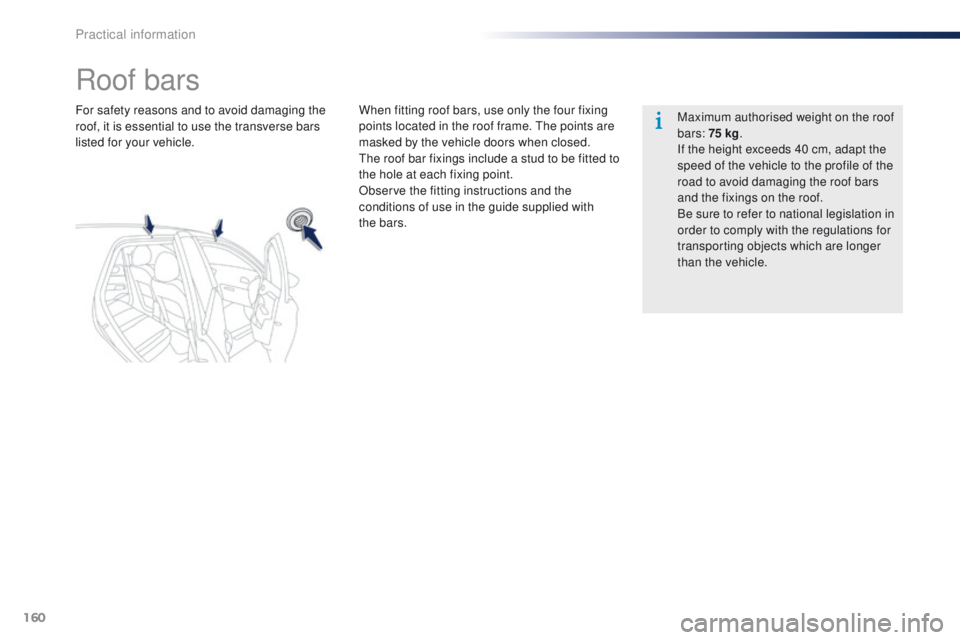
160
301_en_Chap09_info-pratiques_ed01-2014
Roof bars
For safety reasons and to avoid damaging the
roof, it is essential to use the transverse bars
listed for your vehicle.When fitting roof bars, use only the four fixing
points located in the roof frame. The points are
masked by the vehicle doors when closed.
The roof bar fixings include a stud to be fitted to
the hole at each fixing point.
Observe the fitting instructions and the
conditions of use in the guide supplied with
the
bars.Maximum authorised weight on the roof
bars: 75
kg.
If the height exceeds 40 cm, adapt the
speed of the vehicle to the profile of the
road to avoid damaging the roof bars
and the fixings on the roof.
Be sure to refer to national legislation in
order to comply with the regulations for
transporting objects which are longer
than the vehicle.
Practical information
Page 174 of 285
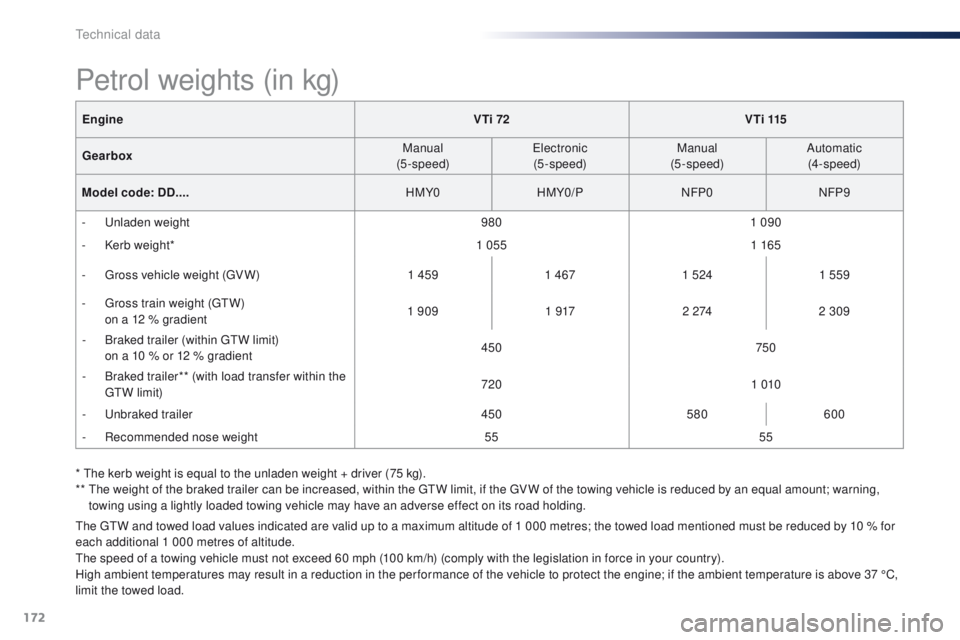
172
301_en_Chap11_caracteristiques-techniques_ed01-2014
EngineVTi 72V T i 115
Gearbox Manual
(5-speed) Electronic
(5-speed) Manual
(5-speed) Automatic
(4-speed)
Model code: DD.... HMY0HMY0/P NFP0NFP9
-
U
nladen weight 9801 090
-
K
erb weight* 1 0551 165
-
G
ross vehicle weight (GV W) 1 4591 467 1 5241 559
-
G
ross train weight (GTW)
o
n a 12 % gradient 1 909
1 9172 2 742 309
-
B
raked trailer (within GTW limit)
o
n a 10 % or 12 % gradient 450
750
-
B
raked trailer** (with load transfer within the
GTW limit) 720
1 010
-
U
nbraked trailer 450580600
-
R
ecommended nose weight 5555
* The kerb weight is equal to the unladen weight + driver (75 kg).
**
T
he weight of the braked trailer can be increased, within the GTW limit, if the GV W of the towing vehicle is reduced by an equal amount; warning,
towing using a lightly loaded towing vehicle may have an adverse effect on its road holding.
The GTW and towed load values indicated are valid up to a maximum altitude of 1 000 metres; the towed load mentioned must be reduced by 10 % for
each additional 1 000 metres of altitude.
The speed of a towing vehicle must not exceed 60 mph (100 km/h) (comply with the legislation in force in your country).
High ambient temperatures may result in a reduction in the per formance of the vehicle to protect the engine; if the ambient temperature is above 37 °C,
limit the towed load.
Petrol weights (in kg)
Technical data
Page 176 of 285
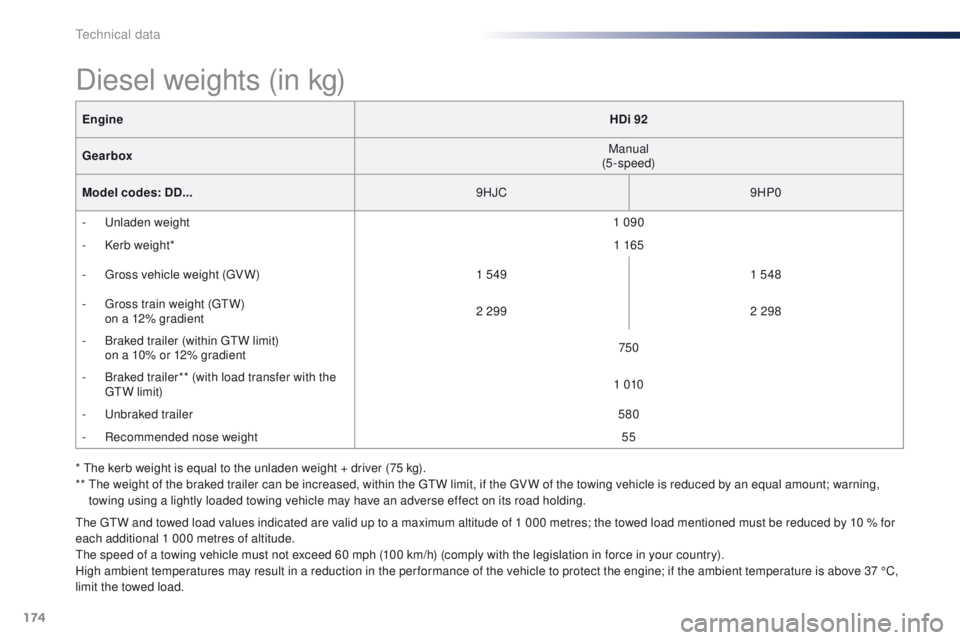
174
301_en_Chap11_caracteristiques-techniques_ed01-2014
The GTW and towed load values indicated are valid up to a maximum altitude of 1 000 metres; the towed load mentioned must be reduced by 10 % for
each additional 1 000 metres of altitude.
The speed of a towing vehicle must not exceed 60 mph (100 km/h) (comply with the legislation in force in your country).
High ambient temperatures may result in a reduction in the per formance of the vehicle to protect the engine; if the ambient temperature is above 37 °C,
limit the towed load. * The kerb weight is equal to the unladen weight + driver (75 kg).
**
T
he weight of the braked trailer can be increased, within the GTW limit, if the GV W of the towing vehicle is reduced by an equal amount; warning,
towing using a lightly loaded towing vehicle may have an adverse effect on its road holding.
Engine
HDi 92
Gearbox Manual
(5-speed)
Model codes: DD... 9HJC9HP0
-
U
nladen weight
1 090
-
K
erb weight*
1 165
-
G
ross vehicle weight (GV W)
1 5491 548
-
G
ross train weight (GTW)
o
n a 12% gradient
2 299
2 298
-
B
raked trailer (within GTW limit)
o
n a 10% or 12% gradient
750
-
B
raked trailer** (with load transfer with the
GTW limit) 1 010
-
U
nbraked trailer
580
-
R
ecommended nose weight
55
Diesel weights (in kg)
Technical data